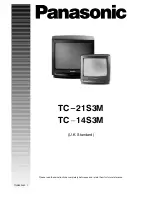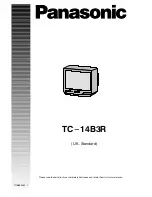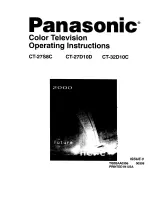
•
Max volume
- adjusts the maximum volume level on the TV. You will not be able to increase
the volume above the set level.
•
Clean everything
- clears all locks.
•
Input settings
– you can assign labels to selected signal inputs.
•
Location
- allows you to automatically customize your TV for your home environment or show-
case your TV in a store.
6.8.4 Additional system menu functions
•
Common interface
- Displays the Conditional Access Module menu.
•
T-link
- enables multiple functions via HDMI CEC. Due to the large number of different devices
introduced to the market, it is not possible to guarantee full support for this protocol for all
devices.
•
Auto source
- on start-up, the TV detects the presence of connected devices and automatically
selects the detected signal input.
•
Sports mode
– activates a mode to enhance viewing of sport content.
•
LED indicator
- allows you to adjust the behavior of the red LED under the TV.
•
Instant power on
- allows you to start your TV from standby faster.
•
Restore factory default
- allows the TV to be reset to the factory settings. The default PIN
for factory reset is 1234 if it has not been changed.
6.9 Support
• You can update your TV software via USB, Internet, or broadcast. At the same time, this menu
shows the software version installed on the TV.
• Always use the latest software version to utilize the latest upgrades, eliminate possible errors
and maximize user experience.
7. Media a PVR recording
The TV supports playback of various media files from USB devices or network storage. If you connect
a USB device to the TV, a dialog box will be displayed offering access to the device.
To access the USB device or network storage again, press HOME and navigate to the TV tab using
the navigation cross. There is a USB item that gives access to the connected USB device and network
storage. To view the contents of the network storage, the TV must be connected to the network
and Share and Watch must be enabled in the TV network settings.
The TV supports basic media file formats. If you experience problems playing or viewing files, the
file format, codec, compression, or some of the file parameters may not be supported. Therefore, full
compatibility with all media files cannot be guaranteed.
Files are sorted into the following categories:
•
All
- Displays all contents of the USB device with all directories and file formats
•
Image
- displays only image files (JPG, JPEG, PNG, BMP). Pictures can be viewed individually
or in slide show mode. While viewing, you can rotate, zoom in or out, or play music files located
on the USB device. Press OK to bring up the Help and Features Console. Press the QBAR button
to open the file view menu.
•
Video
- displays only video files (AVI, MKV, MP4, WMV). Press the OK button to display help
on the available playback functions. Press QBAR to open the file playback settings menu.
•
Music
- displays only audio files (MP3, AAC). Press the OK button to display help on the avai-
lable playback functions. Press QBAR to open the file playback settings menu.
TV OPERATION
EN 18
TV OPERATION
7.1 PVR and Timeshift
Warning!
The TV is equipped with a PVR function designed exclusively for recording free to air (FTA) and unen
-
crypted DVB content for personal use that is not protected by the conditional access system (CAS)!
Making a record of content protected by a conditional access system or otherwise inaccessible content
in a decoded state may violate applicable laws and may also lead to copyright infringement, or violate
other property right of the content provider! Damage compensations and lawsuit might be enforced
by law!
It is forbidden to distribute the records in any way without the permission of the content provider!
By using the PVR function, the user consents to comply with all copyright and property rights relevant
to the recorded content and takes legal responsibility for corresponding actions. The manufacturer,
importer or distributor is not liable for any damages resulting from copyright infringement or violation
of rights, resulting from recordings performed by this TV set.
To access the PVR function, you must first enable this function in the TV settings and connect a com
-
patible USB storage device to the TV. Subsequently, the PVR function can be activated by pressing
the REC button on the remote control, selecting PVR in the TV menu, or scheduling PVR recording
using EPG. The recorded files will be saved to the USB storage device.
When the PAUSE button is pressed, the Timeshift function is activated. When you use this function
for the first time, a menu appears to select the file size reserved for DVB broadcast recording, if the
connected USB device does not contain this file from previous use. To select a different Timeshift file
size, you must remove the Timeshift folder from the USB storage directory and define its size again
when you start the time shift function.
Due to the large number of USB storage introduced to the market, it is not possible to guarantee full
support and flawless operation of all USB storage devices. The TV does not support copying, deleting,
moving, renaming, or other file operations except file opening.
8. Electronic Program Guide (EPG)
This service is provided by your digital broadcasting operator. It informs you about broadcasted pro
-
grams up to 7 days in advance. The extent and relevance of the information provided in the EPG
depends on the operator. For the time information to function properly, it is necessary to synchronize
the system time of the TV with the actual local time.
To display the info table, press the EPG button on the TV remote control. Another way to display
information about the program being broadcasted is to press the „i“ (information) button several times.
The menu disappears after a while or it can be closed by pressing the EXIT button on the TV remote
control.
Program data is transmitted for the entire multiplex (usually 4-10 programs) repeatedly at time inter
-
vals several minutes apart. They are loaded in the same order as they are sent. Information is not
complete until all data has been loaded. Select the program and wait a moment, the data will be filled
in. The loading time is determined by the broadcaster and its bit rate. The more text is transmitted,
the longer it usually takes.
EN 19





































